Sun activity for September 30, 2023: An active and fiery newcomer in the northeast takes the lead
An active and fiery newcomer has begun to make itself known on the sun. Despite low sun activity, what we have seen over the past day indicates a lot of potential. This currently un-numbered yet active region is located on the northeast limb (edge). There also seems to be action from this area due to an active filament, which has been hurling ejecta all day long. NOAA’s GOES-16 satellite observed an Earth eclipse as it entered its eclipse season. At this time, there is one large coronal hole now located at a geoeffective position. Its fast solar wind may be reaching us at any time. Stay with us for more solar news to come.
Last 24 hours: Sun activity continues low, with only 15 C flares over the past day (11 UTC yesterday to 11 UTC today). The largest was a C8.0 flare from sunspot group AR3445 at 6:00 UTC on September 30. The lead flare producer of the day is the incoming region on the northeast limb (edge). It has not been numbered yet but it produced nine of the 15 total flares. The sun currently has six labeled active regions on its Earth-facing side.
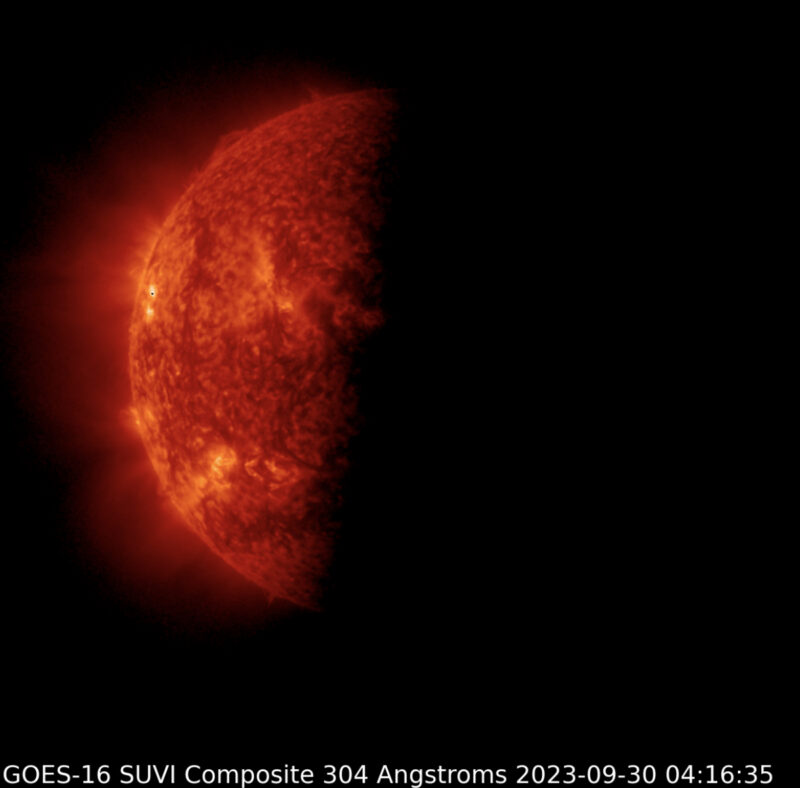
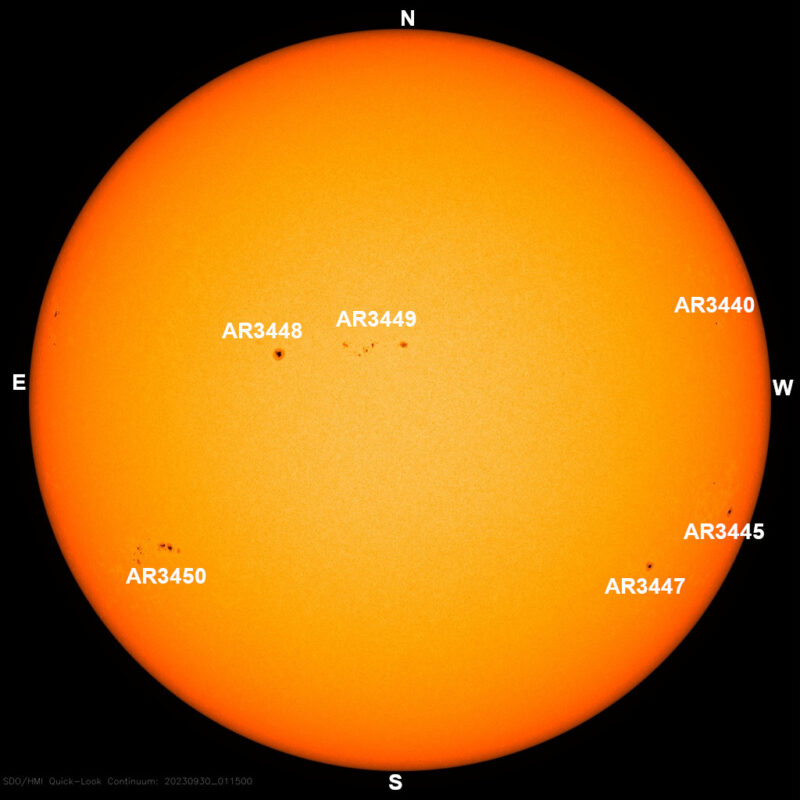
Sun activity for September 29, 2023: Parker Solar Probe’s record-breaking flyby
The Parker Solar Probe has just made a record-breaking pass of the sun. In its quest to get closer and closer to our star, it recently performed a Venus flyby gravity assist. Then, during its latest perihelion (closest point to the sun) on September 27, it was able to pass just 4.51 million miles (7.26 million kilometers) from the solar surface – a new record! In doing so, it also achieved a record-high speed, soaring past our star at 394,736 miles per hour (635,266 kilometers per hour). See the thread below for more information, and enjoy the NASA animation shared above. The Parker Solar Probe will make it closest approach to the sun on December 24, 2024, after one final Venus fly-by on November 6, 2024. Go, Parker Solar Probe!
Last 24 hours: Sun activity is low, with only 11 C flares over the past day (11 UTC yesterday to 11 UTC today). The largest was a C3.1 from sunspot AR3450 at 14:04 UTC on September 28. With five flares, AR3445 was the day’s leading producer. The sun currently has eight labeled active regions on its Earth-facing side.
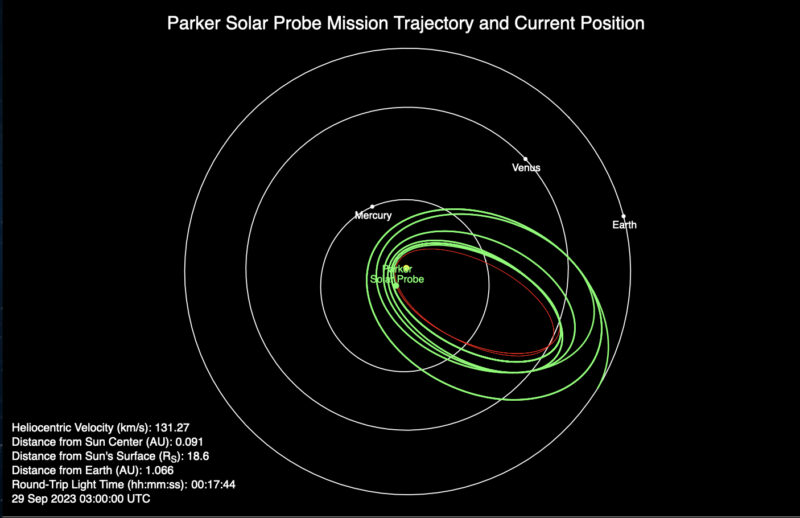

Sun activity for September 28, 2023: Moderate, with an M flare by newcomer AR3450
Newcomer sunspot region AR3450 appeared yesterday over the sun’s southeast limb (edge) and now appears quite active. It was the producer of yesterday’s largest flare, despite not yet being labeled. And it produced an M1.3 flare over the past day, which kicked sun activity levels up to moderate. By the way, are you wondering what happened to comet Nishimura? The comet created a buzz in August, 2023, when first discovered. Many thought it would be bright! The comet is near the sun now. See the tweet below from sun-grazing comet scientist Karl Battams, and watch a beautiful video on comet Nishimura here. And stay tuned for more sun news.
Last 24 hours: Sun activity is now moderate, although flaring production generally continues at a low level. Over the past day (11 UTC yesterday to 11 UTC today), the sun produced only 12 flares. The largest was an isolated faint M1.3 flare, blasted by newcomer active region AR3450 at 9:07 UTC on September 28, 2023. The blast produced an R1 (minor) radio blackout that affected an area over the southwest coast of Africa, north of Madagascar. This newcomer AR3450 is the lead flare producer of the day. It blasted seven flares out of a total of ten for the day. AR3435 lost its delta magnetic complexity (a delta region is a sign of potential for M or even X flares). Sunspot AR3449 is currently showing the most complex magnetic configuration of the day, with a beta-gamma configuration. The sun bears today eight labeled active regions on its Earth-viewed side.
More photos in this video: Comet Nishimura, the beautiful comet almost no one saw

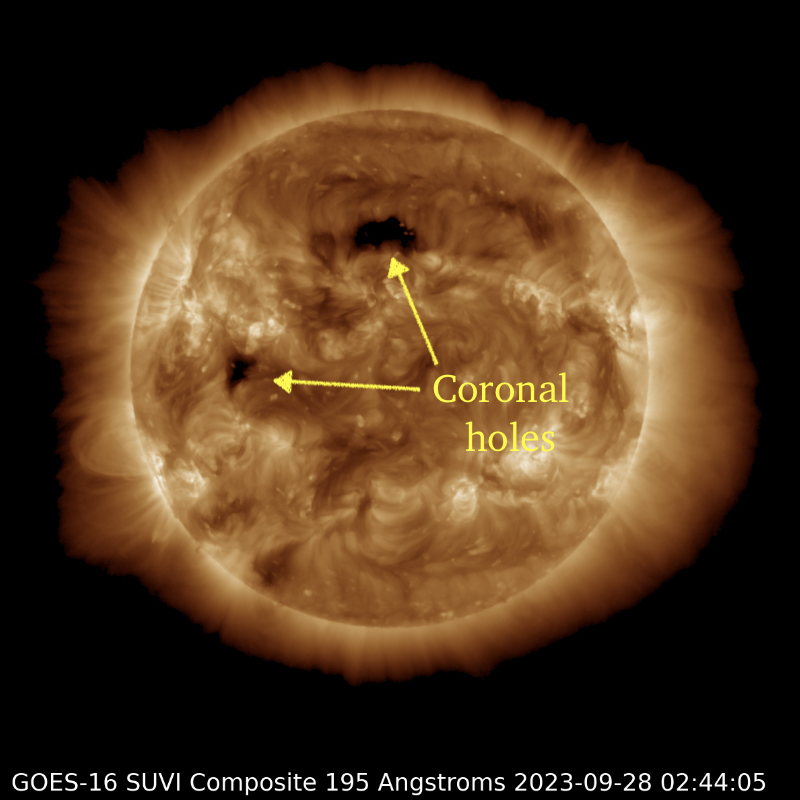
Sun activity for September 27, 2023: Geomagnetic storm brings more auroras!
The G1 (minor) geomagnetic storm we reported yesterday produced beautiful auroras. The G1 disturbance continued through a good portion of the day, calming to active levels (Kp=4) at 2:55 UTC this morning. Meanwhile, although solar activity remains low today, we did see an erupting filament hurling ejecta into space from the vicinity of sunspot AR3447 in the southern hemisphere. Could this be the next event to disturb Earth’s magnetic field? Analysis is ongoing to determine if this blast is coming our way – we’ll let you know!
Last 24 hours: Sun activity remains low. Over the past day (11 UTC yesterday to 11 UTC today), the sun produced 10 C flares. The largest was a C4.7 fired at 5:46 UTC on September 27 by an unnumbered sunspot in the southeast. Sunspot region AR3449 was the lead flare producer with four of the 10 flares. AR3435 kept its delta magnetic complexity. AR3443, AR3445 and newcomer AR3449 all have a less-potent beta-gamma configuration. The sun has eight numbered sunspot regions today, including the aforementioned newcomer.
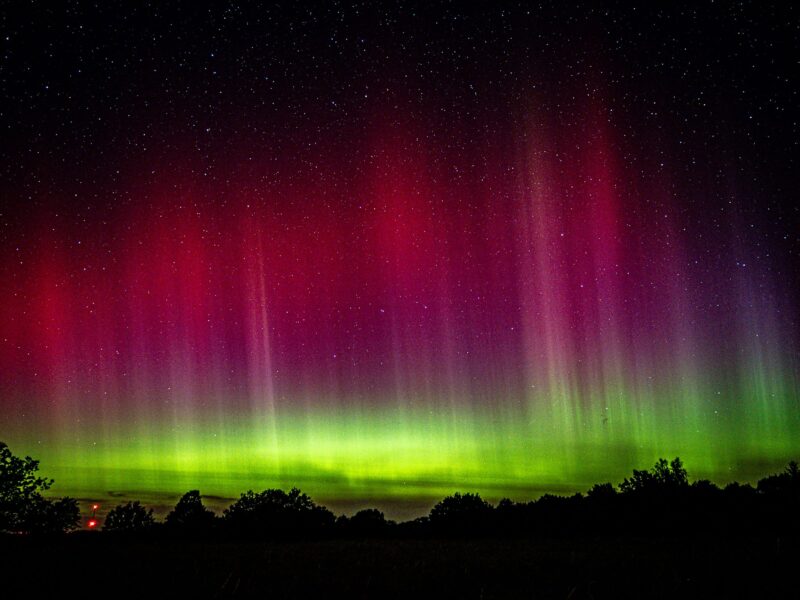
Sun activity for September 26, 2023: Geomagnetic storm expected. More red auroras?
A G1 (minor) geomagnetic storm is ongoing at the time of this writing, with more stormy conditions anticipated through the rest of the day. The G1 threshold was reached at 8:09 UTC this morning. With Earth’s magnetic field still feeling the effects of Sunday’s coronal mass ejection (CME) arrival, NOAA forecasters have issued an alert for auroral displays. Keep an eye out for more red auroras! And don’t forget to share your beautiful aurora photos with us.
Last 24 hours: Sun activity is back to low, but we saw filament eruptions all over the solar disk, particularly in the northeast and northwest. These filaments hurled ejecta into space, and we await the results of specialist analysis to determine if a component of those blasts is coming our way. Over the past day (11 UTC yesterday to 11 UTC today), only C class flares were produced – 18 in total. The largest was a C5.7 from the small but mighty sunspot region AR3445 at 4:28 UTC on September 26. AR3445 also became the lead flare producer of the past day, with ten of the 18 flares. AR3435 and AR3445 currently hold the potential for large flares, as they both show a delta magnetic complexity. The sun has nine numbered sunspot regions today, including two new kids in the neighborhood: AR3447 and AR3448.
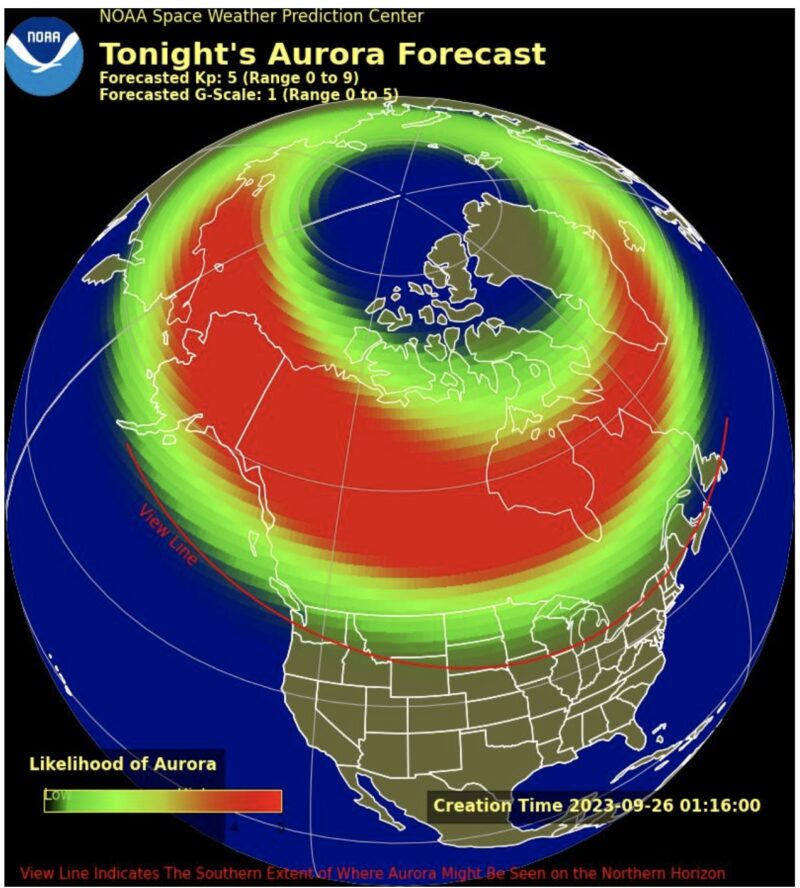
Sun activity for September 25, 2023: Surprise strong CME brings rare red aurora
What fun! Earth experienced a coronal mass ejection (CME) impact late yesterday (September 24, 2023). We’d expected a geomagnetic storm, but not a G3 (strong) storm. But G3 it was! And many in Europe and northernmost North America were surprised with the sight of a rare red aurora. In the aurora, red is created by oxygen in Earth’s atmosphere. This color is one of the more difficult ones to detect with the unaided eye because the human eye is less sensitive to red light. Many past reports of red auroras were associated with extreme magnetic storms. Last night’s storm wasn’t extreme, although it was strong. Why did people see this rare red aurora? We don’t know. But scientists will surely be looking today, trying to understand the conditions that led to these beautiful displays.
Last 24 hours: Over the past day (11 UTC yesterday to 11 UTC today), sun activity was moderate, due to a single M flare. In all, the sun released 18 flares, 13 of which came from yesterday’s hero, AR3445. This sunspot region – though small in size – is turning out to be the little engine that could! But AR3445 didn’t produce the largest flare of the past day. That was an M1 flare from AR3443 at 14:51 UTC on September 24, 2023. The M flare caused an R1 (minor) radio blackout over South America. AR3435 and AR3445 both show some magnetic complexity, with a delta region. The sun currently has nine numbered sunspot regions.
Sun activity for September 24, 2023: Meet sunspot region AR3445 (again)
We have a new kid in town! Well, not new exactly. Sunspot region AR3445 rotated onto the Earth-facing disk of our star a few days ago. It gained a delta region (a possible indication of strong flaring), and it produced a two big flares. Then it went away. Now it has came back! And now it has kicked into high gear and produced a lot of flaring. It produced 15 of the 21 solar flares of the past day. That’s including three of the past day’s four M flares, plus the largest event of the period, an M4.4. AR3445 is far from being the biggest spot region on the sun. It’s little, but mighty! And there’s more news. We might see more auroral activity into the coming week, due to the influence of a coronal hole and the possible arrival of CMEs today and September 26. Read more below, and stay tuned!
Last 24 hours: Sun activity continues at a moderate levels thanks to four M flares during the past day (11 UTC yesterday to 11 UTC today). The sun released a total of 21 flares, 15 of which came from AR3445. This region produced the largest event, an M4.4 flare and two of the other M flares. Each M flare caused an R1 (minor) radio blackout. The breakdown of the M flares and R1 blackouts of the period is:
– M1.6 by AR3446 at 20:14 UTC on September 23. R1 (minor) radio blackout over the Pacific.
– M1.2 by AR3445 at 02:51 UTC on September 24. R1 (minor) radio blackout over Australia.
– M1.9 by AR3445 at 03:09 UTC on September 24. R1 (minor) radio blackout over Australia.
– M4.4 by AR3445 at 03:17 UTC on September 24. The largest of the four, it produced an R1 (minor) radio blackout over Australia.
By the way, the M4.4 was a long-duration event, though it appeared more as a set of smaller flares combined together rather than a single long event. If, like many long duration events, it produced a coronal mass ejection (CME), the region’s position makes it ideal for sending that CME towards us. We await further analysis to know the final outcome. In the meantime, also in the past day, AR3443 gained a delta region. And AR3441 now has a slightly less complex, beta-gamma, magnetic configuration. None of the regions are particularly large, so we’ll see what happens next. The sun currently has 11 numbered sunspot regions.
Sun activity for September 24, 2023: Meet sunspot region AR3445 (again)
We have a new kid in town! Well, not new exactly. Sunspot region AR3445 rotated onto the Earth-facing disk of our star a few days ago. It gained a delta region (a possible indication of strong flaring), and it produced a two big flares. Then it went away. Now it has came back! And now it has kicked into high gear and produced a lot of flaring. It produced 15 of the 21 solar flares of the past day. That’s including three of the past day’s four M flares, plus the largest event of the period, an M4.4. AR3445 is far from being the biggest spot region on the sun. It’s little, but mighty! And there’s more news. We might see more auroral activity into the coming week, due to the influence of a coronal hole and the possible arrival of CMEs today and September 26. Read more below, and stay tuned!
Last 24 hours: Sun activity continues at a moderate levels thanks to four M flares during the past day (11 UTC yesterday to 11 UTC today). The sun released a total of 21 flares, 15 of which came from AR3445. This region produced the largest event, an M4.4 flare and two of the other M flares. Each M flare caused an R1 (minor) radio blackout. The breakdown of the M flares and R1 blackouts of the period is:
– M1.6 by AR3446 at 20:14 UTC on September 23. R1 (minor) radio blackout over the Pacific.
– M1.2 by AR3445 at 02:51 UTC on September 24. R1 (minor) radio blackout over Australia.
– M1.9 by AR3445 at 03:09 UTC on September 24. R1 (minor) radio blackout over Australia.
– M4.4 by AR3445 at 03:17 UTC on September 24. The largest of the four, it produced an R1 (minor) radio blackout over Australia.
By the way, the M4.4 was a long-duration event, though it appeared more as a set of smaller flares combined together rather than a single long event. If, like many long duration events, it produced a coronal mass ejection (CME), the region’s position makes it ideal for sending that CME towards us. We await further analysis to know the final outcome. In the meantime, also in the past day, AR3443 gained a delta region. And AR3441 now has a slightly less complex, beta-gamma, magnetic configuration. None of the regions are particularly large, so we’ll see what happens next. The sun currently has 11 numbered sunspot regions.
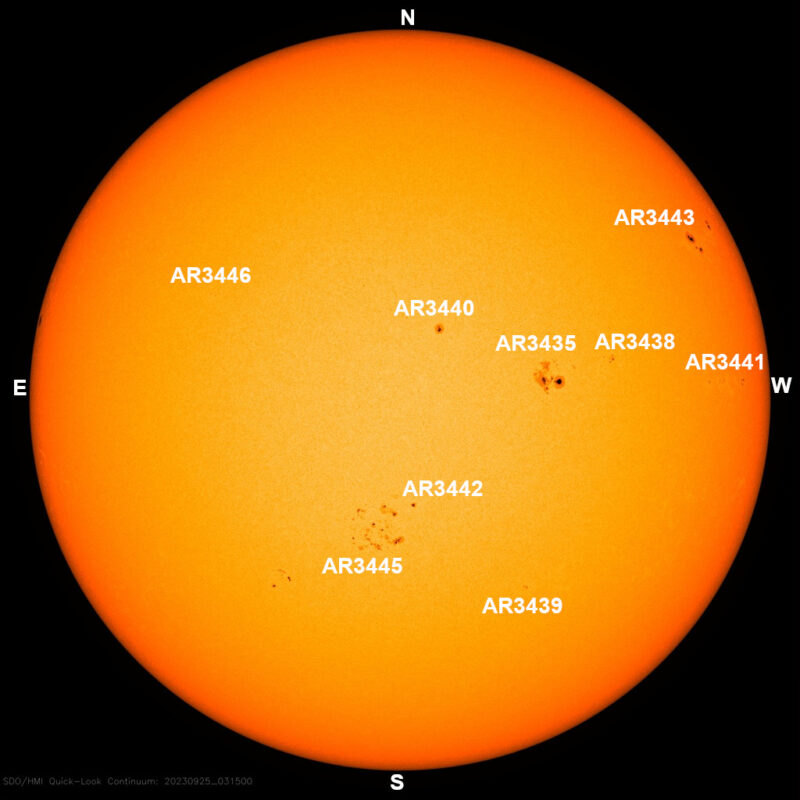
Sun activity for September 23, 2023: Moderate with a chance for equinox auroras
Three M flares with filament explosions and coronal mass ejections (CMEs) have thrown solar particles toward Earth. Sun activity is moderate with sunspot active region AR3443 producing the three M flares, including an M1.4 and then an M1.5 in less than an hour. The third M flare occurred simultaneously with a filament eruption. Scientists are further analyzing the CMEs from the M flares to determine if they’re coming our way. We saw a huge filament eruption early in the day at around 11 UTC (see our animation below). And we anticipate a weekend full of auroral displays due to the arrival of multiple CMEs hurled into space by the M flares produced September 20 through 22. Arrival of the first CME is expected by late today, September 23. This is all coincident with the September equinox, which favors auroras. So this is an alert for aurora chasers. Get out your cameras!
Last 24 hours: Sun activity continues at a moderate level. This time, three M flares kept up the current levels. During the past day, between 11 UTC yesterday and 11 UTC today, the sun released 23 flares: three M flares and 20 C flares. Each M flare caused an R1 (minor) radio blackout. The breakdown of the M flares and R1 blackouts of the period is:
– M1.4 by AR3443 at 16:23 UTC on September 22. R1 (minor) radio blackout over Colombia in South America.
– M1.5 by AR3443 at 17:15 UTC on September 22. R1 (minor) radio blackout over Colombia’s west coast.
– M1.9 by AR3443 at 23:00 UTC on September 22. The largest of the three, it produced an R1 (minor) radio blackout over the middle of the Pacific Ocean south of Hawaii.
Sunspot region AR3443 was the lead flare producer of the day with three Ms and nine Cs. The champion of the week, M flare producer active region AR3445, lost its delta configuration, but AR3443 now shows a beta-gamma magnetic complexity. The sun has 11 numbered active regions.
Sun activity for September 22, 2023. Another almost-X flare!
Deja vu all over again. At first glance, the past day on the sun has seemed like a carbon copy of the day before. Sunspot group AR3435 maintained its delta magnetic configuration, showing continued potential for large M flares or even X-class events. And, sure enough, it gave us another M8 flare midday yesterday, slightly larger than Wednesday’s at M8.7. But one of the striking differences between the two flares is the observation of what’s called coronal dimming. That’s the technical name for a spreading patch of dimmer material, sometimes seen in the surrounding region, following a strong flare. It happens because the amount of solar material (atmosphere) in the region suddenly decreases. So there’s less matter to emit light, and hence we see a dimming. It’s a strong indication that a coronal mass ejection (CME) has occurred; the area is dimmer because mass has been ejected from it. And it’s also a great example of why it’s important to observe sun activity in multiple wavelengths of light. See the 4-paneled image below. In it, the gold image (171 angstrom) shows the coronal structure during the event, the teal image (131 angstrom) shows the super-hot emission of the flare, while the pink and brown images (211 and 193 angstrom) much more clearly show the dimming caused by the CME material leaving the sun. Coronagraph images are not available yet, but we’d expect to see a clear CME moving away from the sun and headed our way. This could possibly be a partial or full halo CME.
Last 24 hours: Sun activity remains moderate with two M flares. During the past day, between 11 UTC yesterday and 11 UTC today, the sun released 10 flares: two Ms and eight Cs. The first M flare, the largest flare of the period, was an M8.7 fired by AR3435 at 12:54 UTC on September 21. The second M, also from AR3435, was an M1.2 at 3:35 UTC on September 22. The eruptions produced corresponding radio blackouts. The first was an R2 (moderate) radio blackout over the Pacific Ocean, southwest of the coast of Liberia in Africa. The second was an R1 (minor) blackout over Indonesia. Sunspot regions AR3443 and AR3441 were the lead flare producers of the day with three C flares each. And looking around the rest of the sun, we were dazzled by the dance of prominences on the solar limb (edge). The sun currently has 11 numbered active regions, including two newcomers: AR3443 and AR3444.
Sun activity for September 21, 2023. An almost-X flare from AR3435
We reported yesterday that sunspot AR3435 had grown in magnetic complexity, indicating that larger flares were possible, and today it’s lived up to its potential. It fired off an M8.2 flare, almost reaching the X flare threshold! The sunspot has retained its delta magnetic complexity, too, so more intense flaring may still be in store. The attention-grabbing M flare was accompanied by filament explosions all over the Earth-viewed sun, as well as mesmerizing prominences on the northwest limb (edge) from regions that recently rotated out of view. Will AR3435 release an X flare before it meets the same fate? Stay tuned.
Last 24 hours: Sun activity remains moderate thanks to the M8.2 that AR3435 fired at 14:19 UTC on September 20. The eruption produced an R2 (moderate) radio blackout over the Atlantic Ocean north of Natal in Brazil. Besides this M flare, the sun released 17 C flares for a total of 18 flares between 11 UTC yesterday and 11 UTC today. The lead flare producer of the period was AR3438, with six C flares. The sun currently has ten numbered active regions, including two newcomers: AR3441 and AR3442.
Sun activity for September 20, 2023 is moderate with an M4 flare. Plus, auroras!
Geomagnetic activity has begun to wane after yesterday’s G3 (strong) geomagnetic storm, but flaring intensity on the sun has picked up with an M4 flare from AR3435. This sunspot’s magnetic complexity has grown to beta-delta, which means it will likely continue to produce M flares and could even hold the potential for an X flare. Elsewhere, we continue to observe filament explosions all over the Earth-viewed side of our star. Our animation below shows a blast by sunspot AR3437 in the southwest, followed by a gorgeous whip-like prominence on the southwest limb (edge). As a result of the yesterday morning’s G3 (strong) geomagnetic storm, auroral displays were observed far and wide; we received photos from Michigan, Wisconsin, Montana, and Scotland. Visit our EarthSky Community Photo section and enjoy them. Thank you to our readers for sharing your beautiful photos.
Last 24 hours: Sun activity is moderate, with an isolated M flare from AR3435 late in the day on September 19. With 17 C flares on top of this, the total flare production was 18 flares between 11 UTC yesterday and 11 UTC today. The largest was an M4.0 flare from AR3435 at 20:14 UTC on September 19. A corresponding R1 (minor) radio blackout affected an area over the Pacific Ocean off the northwest coast of Colombia. AR3436 was once again the top flare producer of the day, with five Cs this time. The sun currently has nine numbered active regions, including a newcomer in the northeast labeled AR3440.

Sun activity for September 19, 2023, is moderate. Big geomagnetic storm last night
The expected coronal mass ejection (CME) arrived early. And it provoked a G1 (minor), G2 (moderate), and up to a G3 (strong) geomagnetic storm early today! The combined effects of a CME that emerged from the sun on September 16 and another that did so on September 17 caused the storms. The effects first struck over Scandinavia and the northern latitudes of Europe. And they also reached North America, with auroras sighted down into the northern U.S. NOAA emitted an alert for Kp=7 conditions. Did you see the auroras? Share your beautiful photos with the EarthSky community!
Last 24 hours: Sun activity is moderate, with two M flares from AR3435 early in the day on September 19. With 16 C flares on top of this, the total flare production was 18 between 11 UTC yesterday and 11 UTC today. The largest event was an M1.89 flare from AR3435 at 9:38 UTC on September 19. An R1 (minor) radio blackout affected Kenya. The other M flare was an M1.1 from AR3435 at 3:55 UTC on September 19. Shortly after that M flare, an R1 radio blackout affected an area over Indonesia. AR3436 was the top flare producer, with ten C flares. The sun currently has nine numbered active regions, including four newcomers: AR3437 in the southwest, AR3438 and AR3440 in the northeast, and AR3439 in the southeast.
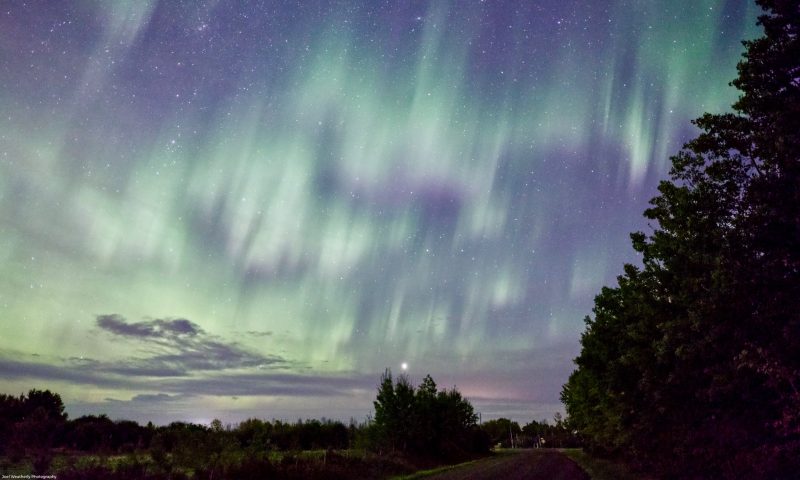
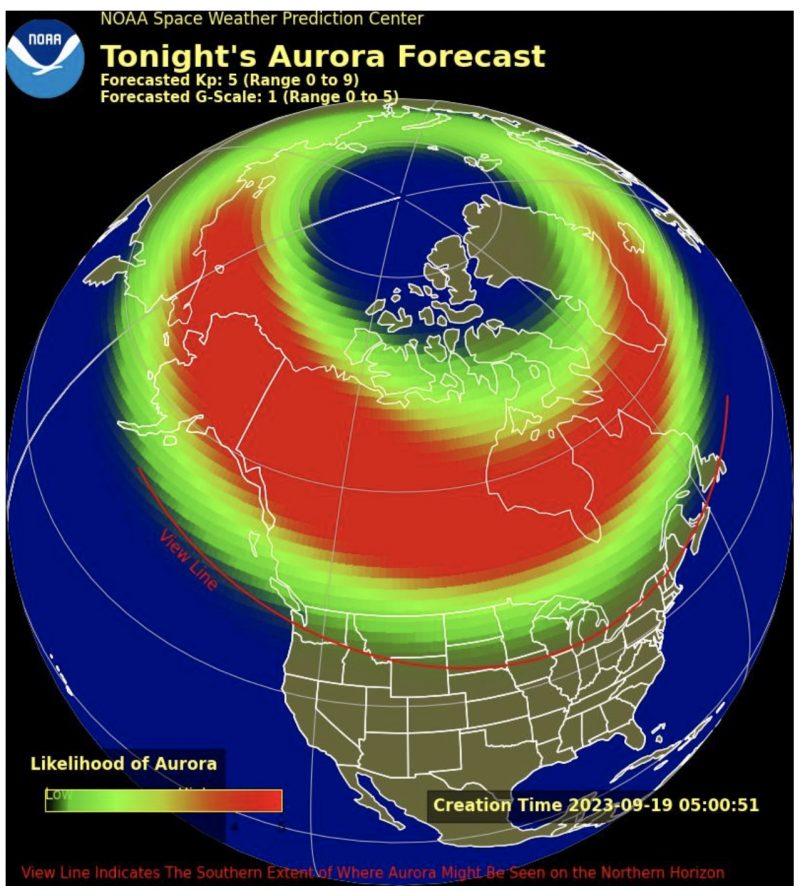
Sun activity for September 18, 2023 is low, with filaments for excitement
Over the past day, the sun produced only C flares, giving us low sun activity. But the sun’s filaments don’t seem to know that. A large filament on the southwest limb (edge) erupted producing a beautiful coronal mass ejection (CME). While the CME largely is directed away from Earth, the event is under analysis to determine if there is an Earth-directed component. The huge rope of solar plasma swirled around the limb (edge) visible in the Solar Dynamics Observatory (SDO) 304-angstrom wavelength channel. It then slowly lifted off from the sun, where the CME was captured by the SOHO LASCO C2 and C3 coronagraphs. Because of SOHO’s perspective, we saw a classic lightbulb shaped CME flying off into space. The Earth’s magnetic field (geomagnetic field) was up until recently, still disturbed by yesterday’s CME arrival. Just before the time of this writing, it again reached G1 (minor) storm levels. But it has now settled back to quiet conditions. Another CME impact is expected for tomorrow, September 19, so stay tuned! There may be more auroras on the way with possible G3 (Strong) storming.
Last 24 hours: Sun activity is low, with eight C flares over the past day. The largest event was a C3.6 flare from AR3435 at 15:55 UTC on September 17. AR3435 was the top flare producer with four of the eight flares. The sun currently has six numbered active regions.
Sun activity for September 17, 2023: A CME is here, with another one on the way
The coronal mass ejection (CME) is here. As expected, the CME from September 14 glanced Earth early on September 17 at 2:32 UTC. It did not cause a geomagnetic storm and only reached active (Kp=4) levels. It could still reach a G1 (minor) geomagnetic storm. Despite the lack of geomagnetic storming some beautiful auroral displays at higher latitudes were reported. Yesterday’s filament eruption produced a CME that is forecast to reach Earth on September 19 in a direct hit. Flaring levels have decreased, bringing sun activity to low. Stay tuned for news on more activity at Earth and on the sun.
Last 24 hours: Sun activity is low, with nine C flares over the past day. The largest event was a C3.7 flare from AR3429 at 15:54 UTC on September 16. AR3429 was the top flare producer with seven of the nine flares. The sun currently has six numbered active regions.
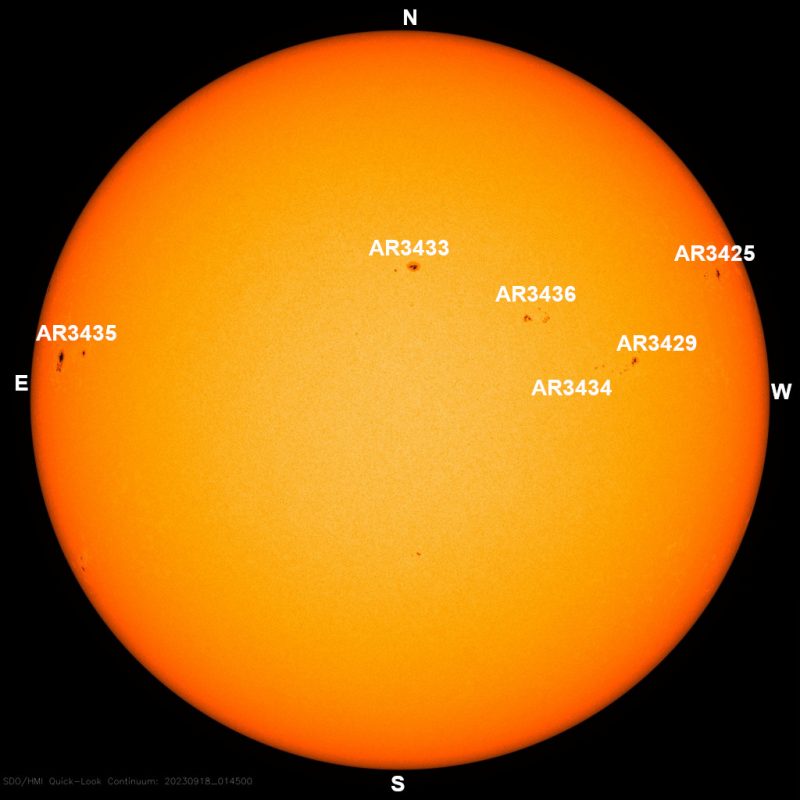
Sun activity for September 16, 2023: Kaboom! Huge filament explosion plus 3 M flares
Kaboom! A huge filament eruption! The long transequatorial filament we have been observing finally provided a big eruption, hurling ejecta into space. This started at around 20 UTC on September 15 and ended at 9 UTC on September 16, 2023. We saw an enormous coronal mass ejection (CME) during the event. Due to its location, there is a good chance that a portion of the ejecta is coming our way, but we need to wait to hear what the specialists say. Sun activity is picking up with three M flares from our flaring hero of the week, sunspot AR3429. Turning our eyes to the northeast limb (edge), there is an active region still on the far side that has been quite active, releasing fiery prominences during the past day. Will this region get still more active? Stay with us for more sun news.
Last 24 hours: Sun activity is moderate, with three M flares over the past day. There were 12 flares, three Ms and nine Cs. Once again, sunspot AR3429 produced the past day’s M flares. The first was an M1.7 flare that exploded at 22:29 UTC on September 15, the second was an M2.9 flare that blasted at 00:50 UTC, and the third was an M3.4 flare at 05:38 UTC on September 16. Three R1 (minor) radio blackouts resulted from the three M flares. The first one affected an area in the middle of the Pacific Ocean south of Hawaii, the second north of New Guinea and the third one the north coast of Indonesia. The lead flare-producer prize again goes to AR3429, which blasted nine of the 12 flares of the day, the three Ms included. The sun currently has six numbered active regions.
Sun activity for September 15, 2023: Bam, bam! 2 M flares in a row
Sunspot AR3429 was very active during the past day, and it eventually blasted two M flares in quick succession. The first was an M1.9 flare at 19:31 UTC on September 14, and the second, less than two hours later at 21:26 UTC, was an M2.5 flare. This region almost single-handedly created an uptick in flaring over the past day, firing off 15 of the 18 total flares! It was also the only sunspot to exhibit growth, with all the other sunspots on the Earth-viewed solar disk remaining stable or decaying. In other news, during the day today we are expecting a glancing blow from a coronal mass ejection (CME) that left the sun on September 11. It may provide conditions for a G1 (minor) geomagnetic storm, bringing the chance for some more auroral displays.
Last 24 hours: Sun activity remains moderate, with two M flares over the past day. But flaring production has picked up, with 18 flares in total between 11 UTC yesterday and 11 UTC today. The largest event was the M2.5 flare from sunspot AR3429 at 21:26 UTC on September 14. Shortly after this M flare, a corresponding R1 (minor) radio blackout was registered over the Pacific Ocean off the southwest coast of Mexico. The same occurred after AR3429’s earlier M flare, too. AR3429 was also the day’s leading flare producer with 15 flares, including the two M flares. The sun currently has six numbered active regions.
Sun activity for September 14, 2023: Moderate with an M1.4 flare, chance for more auroras
Sun activity is back to moderate with the production of an isolated M1.4 flare. The blast was from a large filament in northwest near sunspot region AR3425 at 7:45 UTC on September 14. This area kept flaring over the past day, hurling faint ejecta into space (take a look at the animation below) before finally erupting, producing today’s single M flare. The auroras have subsided, for now, as the effects of September 12’s unexpected coronal mass ejection (CME) wane. But more auroras may be coming! The filament explosion we mentioned on September 11 hurled ejecta into space that may reach us tomorrow and disturb Earth’s magnetic field. Ready for round two, aurora watchers?
Last 24 hours: Sun activity is moderate. Flaring production decreased to only six flares between 11 UTC yesterday and 11 UTC today: one M and five Cs. The largest was the above-mentioned M1.4 flare from a large filament eruption in the vicinity of AR3425 at 7:45 UTC on September 14. The M flare caused an R1 (minor) radio blackout over the middle of the Arabian Sea. The lead flare producer of the day was region AR3429 with three C flares, while AR3423 remains the largest active region on the Earth-viewed solar disk. The sun currently has six numbered active regions.
Sun activity for September 13, 2023: Unexpected geomagnetic storm last night. Aurora alert!
An unexpected coronal mass ejection (CME) hit Earth’s magnetic field last night and caused a G1 (minor) geomagnetic storm, which then intensified to a G2 (moderate) storm. The CME was likely fired into space after a filament eruption on September 8–9, and eventually collided with Earth on September 12 to trigger the G2 (Kp=6) storm threshold at 17:59 UTC. All of this means: auroras! There have been reports of auroras as far south as Oslo, Norway, and the Sound of Islay in Scotland. Check out some of the beautiful images below. G1 storm conditions may extend through September 13, meaning the chance for more auroral sightings. Alerting all aurora watchers!
Last 24 hours: Sun activity is low. There were only 13 C flares produced in the past day (11 UTC yesterday to 11 UTC today). The largest was a C5.6 flare from sunspot AR3423 at 22:00 UTC on September 12. This region was also the lead flare producer of the period, with four C flares. The sun currently has six numbered active regions, including a newcomer in the northeast now numbered AR3433.

Sun activity for September 12, 2023: Action picking up with 4 M flares!
Sun activity is picking up! Over the past day, we observed four M flares across three different sunspot regions. This increase in intense flares has come alongside an increase in magnetic complexity for three regions, including two of the M flare producers. The more magnetically complex the sunspot, the higher the likelihood that it will produce high-intensity flares. AR3421 even developed a delta region, which makes it a good candidate for larger M flares and even X flares. Aside from magnetic growth, we’ve seen growth in size, too. AR3423 is getting even larger, and is big enough to be visible from the ground, as long as you make sure to use the proper eye protection. On top of all this excitement, multiple halo coronal mass ejections were observed in the LASCO C3 coronagraphs onboard the SOHO spacecraft. At least two of them appear to have been fired from the far side of the sun, so none of the plasma they sent into space will be heading our way. However, it does mean that the sunspots that produced these ejections could be rotating into our view soon!
Last 24 hours: Sun activity is moderate. There were four M flares and 15 C flares in the past day (11 UTC yesterday to 11 UTC today). This is a breakdown of the M flares produced during the period. Each M flare produced a corresponding R1 (minor) radio blackout:
M1.1 at 14:49 UTC by AR3431 on September 11. R1 over the north coast of Brazil.
M1.9 at 4:31 UTC by AR3425 on September 12. R1 over Indonesia.
M1.9 at 5:13 UTC by AR3425 on September 12. R1 over Indonesia.
M2.6, the largest, at 7:07 UTC by AR3423 on September 12. R1 over the Indian Ocean.
Sunspot group AR3425 produced the most flares with two M flares and three Cs. The sun currently has eight numbered active regions.
Sun activity for September 11, 2023: Yes! Fantastic filament eruption and flare
It’s definitely not a blue Monday on the sun! After a relaxing sun day yesterday, sun activity has risen to moderate levels, thanks to two M flares. First, sunspot AR3429 erupted with a filament and an associated M1.4 flare. The eruption created a coronal mass ejection (CME) off to the east of the sun, as seen from Earth. But further analysis might show it will provide a glancing blow – and possible auroral activity – at Earth. Not to be outdone, AR3431 countered with a flurry of flares, starting with an M1.1, then several C flares including a C9.3. In the background, AR3423 is quickly growing in size and magnetic complexity. You can see this sunspot from the ground! Just be sure to view the sun safely with the proper eye protection. This big sunspot hasn’t done much else yet. Stay tuned, to see if it’ll let loose its magnetic potential.
Last 24 hours: Sun activity is moderate, with two M flares and 14 C flares in the past day (11 UTC yesterday to 11 UTC today). The largest was an M1.4 flare from active region AR3429 at 3:58 UTC on September 11. Sunspot group AR3431 produced the most flares with one M flare and seven C flares including an M1.1 flare. The sun currently has nine numbered active regions.
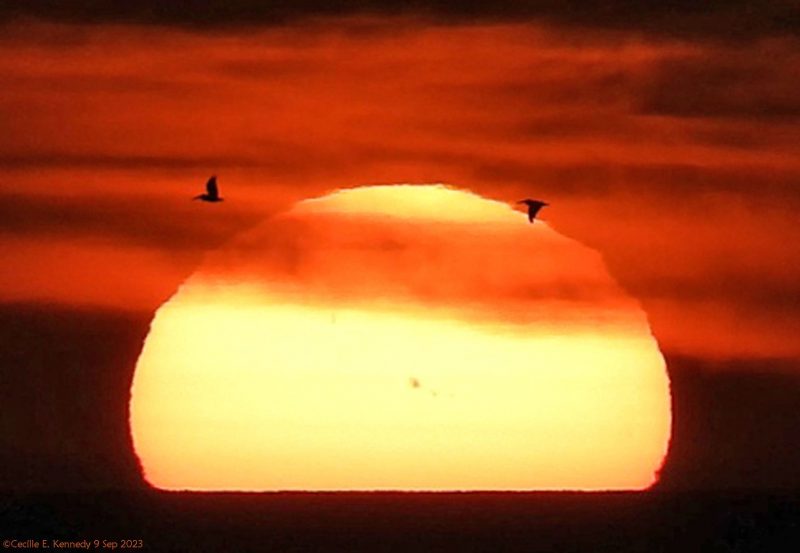
Sun activity for September 10, 2023: Wavelengths and temperatures
We’re approaching another peak in the 11-year solar cycle (expected in mid-decade). Yet the past day has been relatively calm. The animated set of four images – above – shows the sun at different wavelengths (temperatures) and layers of the sun.
– The red color (304 angstroms) shows temperatures of ~80,000 degrees Celsius. The long, dark structures in the north and southeast (right side) are filaments.
– The gold color (171 angstroms) shows temperatures of ~100,000 degrees Celsius. The bright areas with loops coming out of them are the active regions over sunspots.
– The pink image (211 angstroms) shows temperatures of ~2 million degrees Celsius. The dark areas in the north and south are coronal holes.
– The last image, teal (131 angstroms) show ~10 million degrees Celsius. The bright flashes are solar flares.
Now compare the gold image to the large, yellow (visible light) sunspot image below. That yellow image shows temperatures of ~6,000 degrees Celsius. As we go from shorter wavelengths (and higher temperatures), we are looking at higher layers of the sun from the photosphere (visible light) to the chromosphere (304 angstroms) to the corona (171, 211, and 131 angstroms). This highlights the famous coronal heating problem. Why does the sun get hotter as you move farther away from the surface?
Last 24 hours: Sun activity is low, with only C flares. We saw 14 C flares in the past day (11 UTC yesterday to 11 UTC). The largest was a C8.3 flare from active region AR3423 at 01:41 UTC on September 10. Sunspot group AR3423 produced the most flares with five C flares including the C8.3 flare. The sun currently has five numbered active regions.
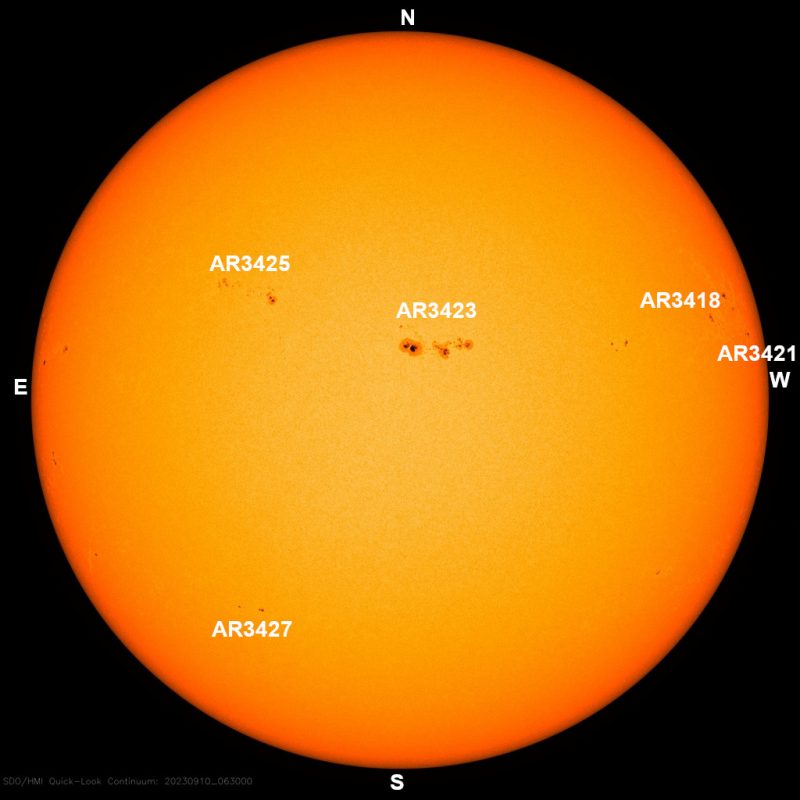
Sun activity for September 9, 2023: A snake-like prominence and an almost-M flare
Sunspot AR3425 continued flaring all day, over the past day. But there was very little ejecta associated with the flares. Take a look at our top animation. It depicts the active filament/prominence that looked like a snake, undulating upwards into space. There was a C2.6 flare associated with this event at 18:19 UTC on September 8. Elsewhere on the solar disk, active region AR3421 almost reached moderate levels with an almost-M flare, a C8.5 flare at 01:20 UTC on September 9. GOES-16 SUVI 304 angstrom registered a faint flare, some ejecta can be seen blasting into space. A full-halo event was observed by SOHO’s LASCO C2 (11:36 UTC) and C3 (11:54 UTC). But no associated event was seen on the Earth-facing side of the sun, so this explosion must have occurred on the far side.
Last 24 hours: Sun activity is back to low, with the production of only C flares. We saw 14 C flares in the past day (11 UTC yesterday to 11 UTC). The largest was a C8.5 flare – an almost-M flare – from active region AR3421 at 01:20 UTC on September 9. Both sunspots, AR3421 and AR3425 were active flare producers over the past day, but AR3421 wins first place since it produced seven C flares, the C8.5 included. AR3425 released four flares. The sun currently has five numbered active regions.
Sun activity for September 8, 2023: New sunspot says hello with a bang
Newcomer sunspot group AR3425 has introduced itself with a bang, raising sun activity to moderate. Shortly after 19 UTC last night, it fired off an M2.1 flare with an impressive filament eruption. The Solar Dynamics Observatory (SDO) and the GOES-16 satellite both observed ejecta being fired out into space. You can see the coronal mass ejection (CME) in the SOHO spacecraft’s LASCO C2 and C3 imagery below. The blast also created a type II radio burst, which is very useful because it can provide an estimate of the CME’s speed. So we know that the CME has a speed of roughly 1,238 km/s, but we are waiting on further analysis to know if any part of it might collide with Earth. Stay tuned!
Last 24 hours: Sun activity is back to moderate thanks to AR3245’s M2.1 flare at 19:09 UTC on September 7. This flare was the largest of the past day. In total, the sun blasted 18 flares between 11 UTC yesterday and 11 UTC today: the above-mentioned M, plus 17 C flares. The M flare caused an R1 (minor) radio blackout over the Pacific Ocean, south of Mexico’s west coast. The lead flare producer today is the newcomer AR3425, which fired four flares including the M flare. The sun currently has seven numbered active regions.
Sun activity for September 7, 2023: Sunspots pick up the pace, more on the way
After yesterday’s focus on filaments, sunspots appear to be taking back the limelight. The newest sunspot regions have been increasing in flare productivity and growing in size, with AR3423 in the northeast showing particularly significant growth compared to yesterday. And it seems that more sunspots are on the way. We can see several sets of coronal loops (bright arcs of plasma driven by the sun’s magnetic fields) protruding from the sun in the east, and these might have been produced by sunspot regions that will soon rotate into view. Plus, helioseismology has detected a large region on the sun’s far side, several days away from coming round to the Earth-viewed portion of our star. And helioseismology isn’t the only way of tracking the activity on the unseen side of the sun. At around 14 UTC on September 5, the SOHO spacecraft’s LASCO C3 instrument registered several coronal mass ejections (CMEs) emerging from the sun as beautiful halos (be sure to take a look below). When specialists failed to identify any flares on the Earth-facing side of the sun that could have caused these bursts, they knew that these explosions had to have occurred on the sun’s far side.
Last 24 hours: Sun activity is low with only C flares, but there were a lot of them; over the past day (11 UTC yesterday and 11 UTC today), the sun produced 16 C flares. The largest was a C5.3 fired at 17:56 UTC on September 6 from AR3421. While this region lost some size and magnetic complexity over the past day, it still retained its prize for lead flare producer, this time firing off eight of the 16 flares of the period. The sun has eight numbered active regions today. The bright area that we saw coming our way yesterday from the northeast has rotated into view and is now labeled AR3425.
Sun activity for September 6, 2023: Twisting, dancing prominence
The sun is alive with filaments – that is, ropes of solar material arcing up from the solar surface. Some of these filaments are erupting within the solar disk, but most can be seen around the limb (edge) of our star. Filaments that can be seen protruding over the limb are known as prominences. The most notable prominence observed over the past day was the winding dance on the south pole that you can see above. As it erupted, it twisted in a tornado-like motion and sent plasma off into space. Elsewhere, we saw bright filament loops on the northeast limb and eruptions on the southeast limb. As the east of the sun is rotating towards us, these filaments may have been produced by sunspots that will come into view over the next few days. Stay tuned!
Last 24 hours: Sun activity remains a moderate. Over the past day (11 UTC yesterday and 11 UTC today), the sun produced 12 flares: two M flares and ten C flares. The largest was an M1.2 fired at 19:45 UTC on September 5 by AR3421, which then followed this up with an M1.0 at 23:39 UTC. Both M flares produced R1 (minor) radio blackouts. The first affected an area in the middle of the Pacific Ocean off the west coast of Baja California, Mexico, and the second occurred south of Hawaii over the Pacific Ocean. Not only did AR3421 produce both M flares, but it once again obtained the prize for lead flare producer, firing off ten of the 12 flares. The sun has eight numbered active regions today. One is a new kid on the block, AR3424, located close to the limb in the northeast.
Sun activity for September 5, 2023 is moderate with 25 total flares!
What’s a week to the sun? It’s just over a quarter-turn in the sun’s 27-day rotation. Last week was – from our earthly perspective – a quiet week on the sun. But now, not surprisingly, sun activity has picked up. It’s back to moderate, with 25 total flares in the past day, including an M2.0 flare from sunspot region AR3421. This sunspot is an interesting one. Aside from producing the largest flare of the past day, it has grown very quickly, since emerging near the center of the solar disk on September 3. It’s now the largest region on the Earth-viewed sun. We also saw a delta region starting to form – where a large bundle of magnetic field lines has broken through the sun’s surface, forming the primary sunspot – and with a smaller spot that has emerged nearby, creating a magnetically complex region where particles are energized and can then be violently expelled! But – for AR3421 – the delta region isn’t quite there yet. Check out our imagery above to see AR3421’s development. This region could be our next source of geoeffective action, that is, action that will affect Earth with magnificent auroral displays. Stay tuned.
Last 24 hours: Sun activity is back to moderate. Over the past day (11 UTC yesterday and 11 UTC today), the sun produced 25 flares: one M, 22 Cs, and 2 B flares. The southeast is showing a lot of solar activity. A fiery newcomer on the southeast limb (edge) fired a C2.4 flare at 12:54 UTC on September 4 with a beautiful filament eruption. Also, former Earth-facing sunspot AR3413 kept up its activity from beyond the northwest limb (edge), releasing a C6.6 at 11:06 UTC on September 4. This flare may actually have been larger than C6.6, since it was partially occulted (blocked) by the sun. AR3421’s above-mentioned M flare caused an R1 (minor) radio blackout over the Arabian Sea. AR3421 was the lead flare producer of the day, with nine flares including the M flare. The sun currently has seven labeled active regions. There are two newcomers in the northeast: AR3422 and AR3423.
Sun activity for September 4, 2023, is low. Aurora season approaches
This weekend’s momentary high sun activity is over. It was fun, though! And the coronal mass ejection (CME) that hit on Saturday (September 2) – though having a relatively weak impact – brought us some nice auroral displays. Weak impact, but nice auroras … why? It could be the time of year. The September equinox is coming. And – around the September and March equinoxes – the geometry of the Earth and sun is such that auroral displays are more likely. That’s why solar physicists call this time of year aurora season. If this 2023 autumn aurora season combines with some higher activity from CMEs directed our way, look out for some spectacular auroras!
Last 24 hours: Sun activity is back to low. Over the past day (11 UTC yesterday and 11 UTC today), the sun produced 16 C flares and one B flare, and no Earth-directed CMEs. The largest was an C5.8 flare from sunspot AR3413 at 12:03 UTC on September 4. The sun has six labeled active regions.
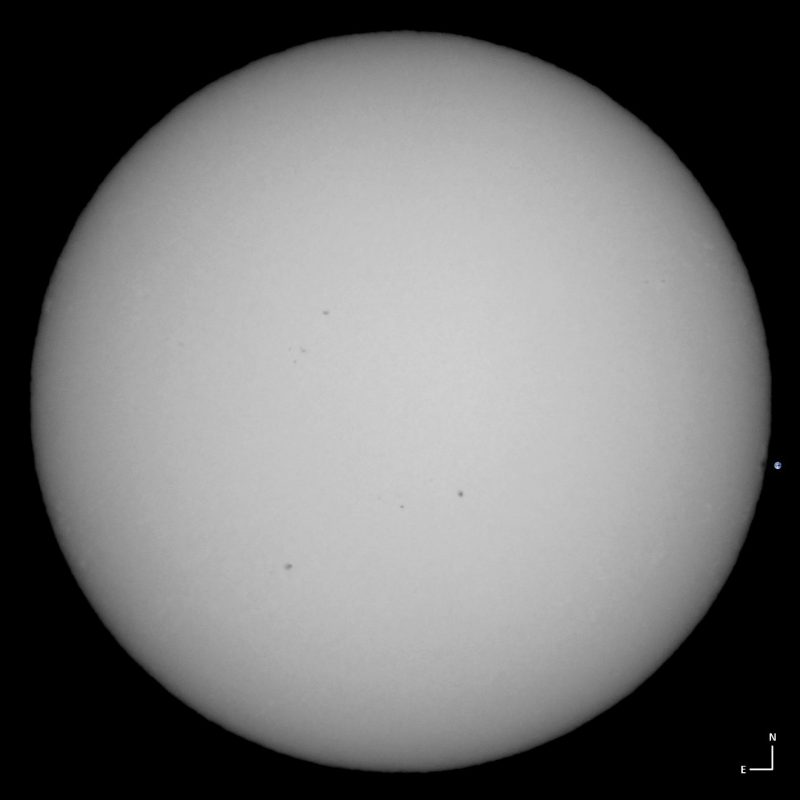
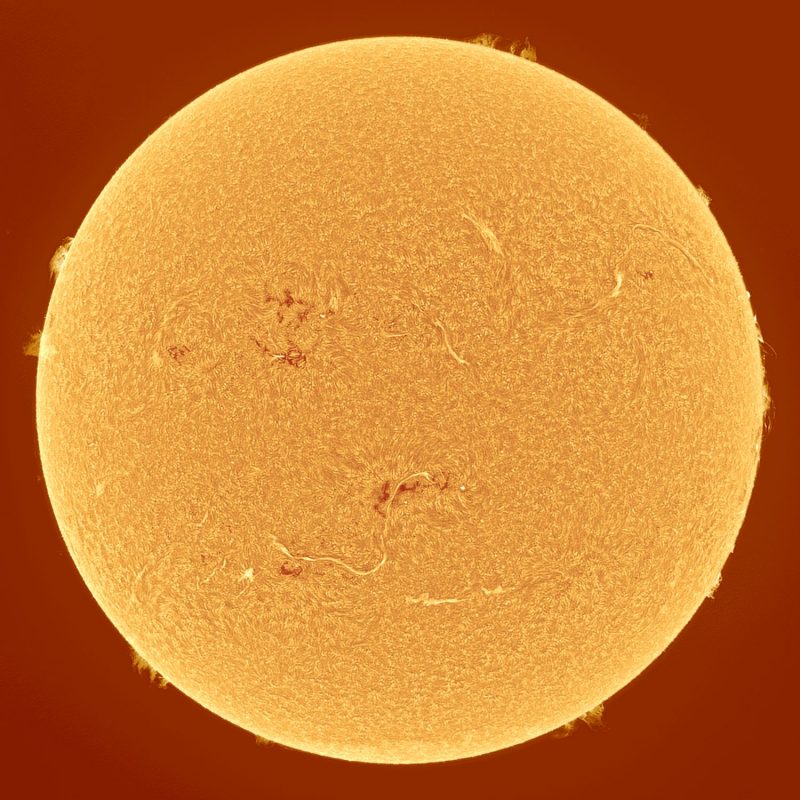
Sun activity for September 3, 2023, is high. Plus, auroras last night!
Auroras are here! Yesterday’s CME impact disturbed Earth’s magnetic field to the point of G1 (minor) storming. The storms began at about 12 UTC on September 2. By about 3 UTC September 3, they reached G2 (moderate) levels. People reported auroral displays across southern Canada and down into the upper U.S. states such as Wisconsin. And good conditions for auroras are expected to continue until at least tonight (night of September 3). Meanwhile, on the sun itself, the time of this writing, AR3413 released an M6 flare. So sun activity is now considered high. Given the position of the region over the west limb (edge), the flare was most certainly larger than M6. The event also released solar plasma producing a coronal mass ejection (CME), but it was largely directed away from the sun. We await further auroral images. Stay tuned!
Last 24 hours: Sun activity is high. The sun produced 14 flares between 11 UTC yesterday and 11 UTC today: two M, 11 Cs, and one Bs. The largest was an M6 flare from sunspot AR3413 at 8:09 UTC on September 3. Shortly after the M flare, an R2 (minor) radio blackout occurred over Africa, the Middle East, and India. The sun also produced an M1.1 at 00:14 UTC from AR3413. The sun has five labeled active regions.

Sun activity for September 2, 2023. Conditions are ripe for auroras
The expected coronal mass ejection (CME) glancing blow is here. Earth’s magnetic field is now at G1 (minor) geomagnetic storm levels. And that means auroras! This CME is the result of solar activity from August 30. The threshold for a G1 storm (a Kp = 5) was reached at 08:10 UTC on September 2, 2023. NOAA had issued a G1 alert with chances for a G2 (moderate) storm. SOHO’s LASCO coronagraphs observed a CME from yesterday’s long-duration M1 flare. Analysis shows a chance for a glancing blow on September 5. Auroras may appear to observers at latitudes as far south as northern Michigan and Maine. The sun itself is maintaining its moderate levels with an M3.4 flare. The event produced a CME, and we await further analysis to determine whether there could be an Earth-directed component. The next few days could be filled with a lot of amazing aurora. Share your beautiful photos of auroras with us! Stay tuned for more sun news.
Last 24 hours: Sun activity is moderate. The sun produced six flares between 11 UTC yesterday and 11 UTC today: one M, three Cs, and two Bs. The largest was an M3.4 flare from sunspot AR3413 at 07:12 UTC on September 2. Shortly after the M flare, an R1 (minor) radio blackout occurred over an area southwest of India. An incoming active region on the sun’s southeast, not numbered yet, was the lead flare producer of the period with four out of the six flares of the day. The sun has five labeled active regions.
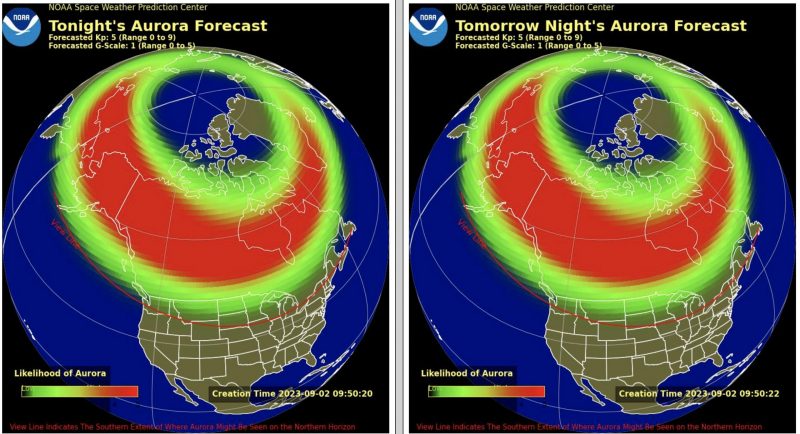
Sun activity for September 1, 2023. Here comes the sun, with 3 M flares!
We hadn’t seen an M flare since August 26. But earlier today we saw three M flares in a row! With them, we are back to moderate levels. An M1.0 opened the door at 03:18 UTC today (September 1), shortly followed by an M1.2 flare at 03:51 UTC, and another M1.2 at 03:52 UTC. The three blasts came from sunspot region AR3413, the region we reported as a mixed-up sunspot due to its changing polarity. The three M flares – so close together in time – can also be considered a long-duration M flare. Take a look at our animation below. We can see ejecta hurled out at the moment of the blast, and a part of it returning back to the sun. At a certain moment, the magnetic bonds that keep the plasma in a loop disengaged. At that point, part of the plasma went away out into space. AR3413 is nearing the sun’s west limb (edge). It’ll soon depart to the far side of our sun, the side we don’t see from Earth. The coronal mass ejection (CME) produced in the M flare(s) might not be coming our way. But we need to wait for the modeling and analysis, because, chances are, a component will come to us. The eruption also produced a blast of high-energy particles, a solar particle event, that reached an S1 level on the NOAA scale. Will AR3413 release more M flares before it departs to the far side? Is sun activity picking up? By the way … aurora alert for this weekend! See below.
Last 24 hours: Sun activity is moderate. The sun produced 10 flares between 11 UTC yesterday and 11 UTC today: three Ms, five Cs, and two Bs. The largest was an M1.2 flare from sunspot AR3413. Shortly after the M flares, an R1 (minor) radio blackout was noted, affecting the Philippines. Sunspot AR3413 was the lead flare producer of the period. It kept blasting all day long. It produced a total of eight flares: three Ms and five Cs. The sun has five labeled active regions.











